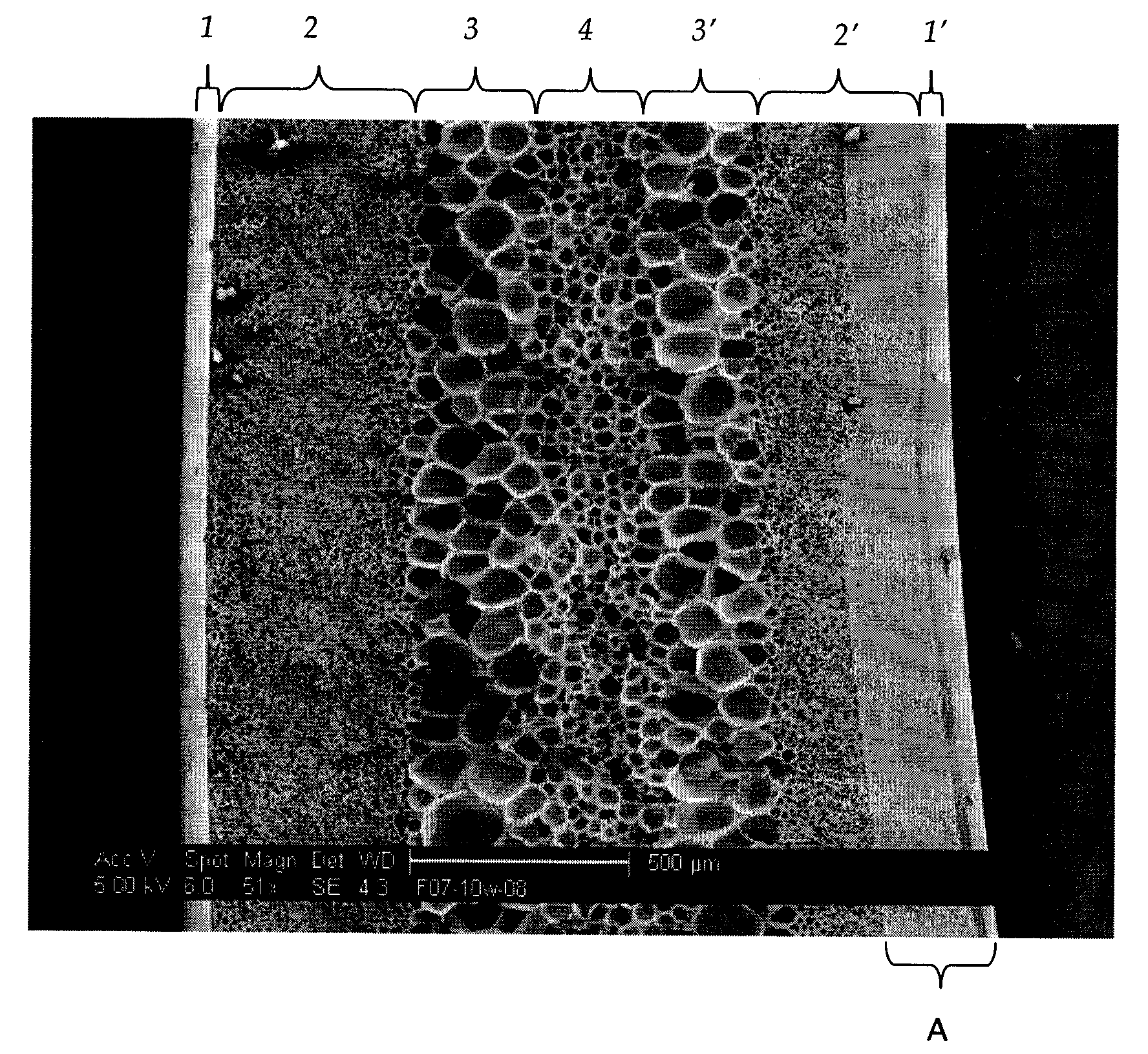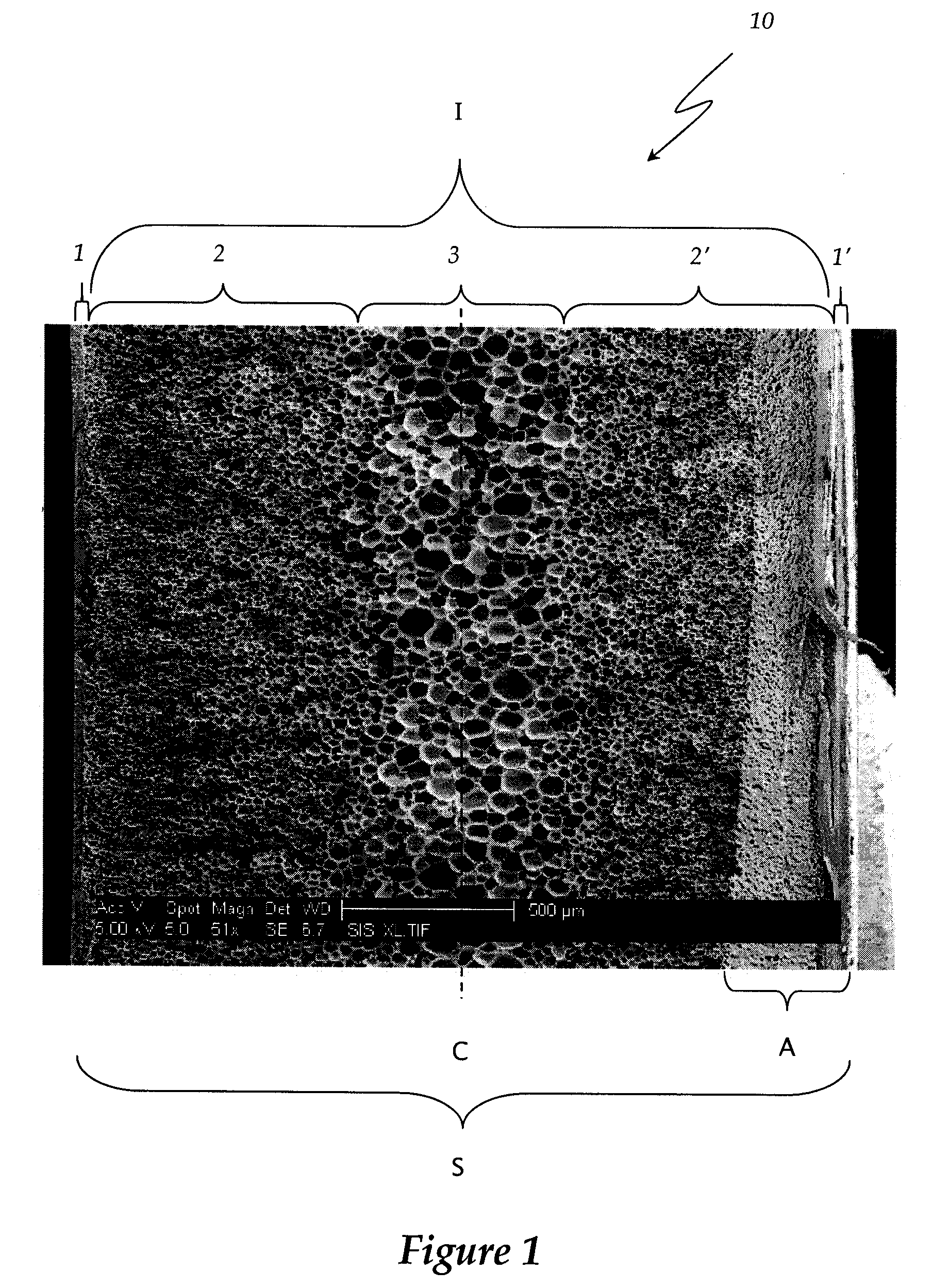Multi-layered foamed polymeric objects and related methods
a polymer object and polymer technology, applied in the field of foamed thermoplastic materials with multi-layered structure, to achieve the effect of first bulk crystallinity level
- Summary
- Abstract
- Description
- Claims
- Application Information
AI Technical Summary
Benefits of technology
Problems solved by technology
Method used
Image
Examples
example 1
[0046]A 3.8 cm diameter circular section of polymer was punched from 0.107 cm thick sheet of recycled PET (RPET) acquired from LaVergne (The LaVergne Group, Canada). The polymer was then wrapped in a paper towel and placed in a pressure vessel (˜21° C.) at 5.0 MPa for 72 hours for the purpose of carbon dioxide absorption. After absorption, the polymer was transferred to a freezer (˜0° C.) for 24 hours to allow carbon dioxide desorption. The polymer was then removed and placed at room temperature (˜20° C.) for one hour for further desorption. The polymer was then heated (˜100° C.) in a silicon bath for 30 seconds to initiate foaming. FIG. 1 is a scanning electron micrograph showing a partial cross-sectional view from the center of the thermoformed circular polymer section manufactured using the above procedure.
example 2
[0047]A 3.8 cm diameter circular section of polymer was punched from 0.107 cm thick sheet of recycled PET (RPET) acquired from LaVergne (The LaVergne Group, Canada). The polymer was then wrapped in a paper towel and placed in a pressure vessel (˜21° C.) at 5.0 MPa for 36 hours for the purpose of carbon dioxide absorption. After absorption, the polymer was transferred to a freezer (˜0° C.) for 24 hours to allow carbon dioxide desorption. The polymer was then removed and placed at room temperature (˜20° C.) for one hour for further desorption. The polymer was then heated (˜100° C.) in a silicon bath for 30 seconds to initiate foaming. FIG. 7 is a scanning electron micrograph showing a partial cross-sectional view from the center of the thermoformed circular polymer section manufactured using the above procedure.
example 3
[0048]A 10 cm×15 cm rectangular section of polymer was cut from 0.107 cm thick sheet of recycled PET (RPET) acquired from LaVergne (The LaVergne Group, Canada). The polymer was then wrapped in a paper towel and placed in a pressure vessel (˜21° C.) at 5.0 MPa for 49 hours for the purpose of carbon dioxide absorption. After absorption, the polymer was transferred to a freezer (˜0° C.) for 24 hours to allow carbon dioxide desorption. The polymer was then removed and placed at room temperature (˜20° C.) for one hour for further desorption. The polymer was then loaded into a thermoformer clamping frame, wherein the polymer was heated (˜110° C.) using infrared heat for 8 seconds and simultaneously stretched to initiate foaming. FIG. 8 is a scanning electron micrograph showing a partial cross-sectional view from the center portion of a thermoformed rectangular polymer section manufactured using the above procedure.
PUM
| Property | Measurement | Unit |
|---|---|---|
| Temperature | aaaaa | aaaaa |
| Temperature | aaaaa | aaaaa |
| Fraction | aaaaa | aaaaa |
Abstract
Description
Claims
Application Information
 Login to View More
Login to View More - R&D
- Intellectual Property
- Life Sciences
- Materials
- Tech Scout
- Unparalleled Data Quality
- Higher Quality Content
- 60% Fewer Hallucinations
Browse by: Latest US Patents, China's latest patents, Technical Efficacy Thesaurus, Application Domain, Technology Topic, Popular Technical Reports.
© 2025 PatSnap. All rights reserved.Legal|Privacy policy|Modern Slavery Act Transparency Statement|Sitemap|About US| Contact US: help@patsnap.com



